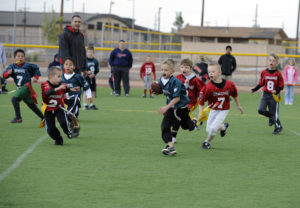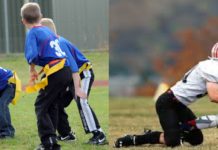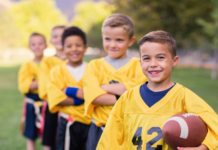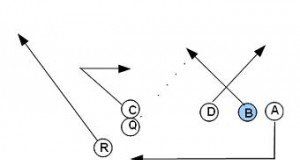
Want an odd blend of “basketball” and “football”?
If so, try flag football. It’s fun, less brutal than normal football – and requires lots of skill! To know the basic skills of Flag Football Drills for Kids, click here.
Below, we’ll discuss some of the flag football positions. Keep them in-mind in case you decide to watch one of its games!.
Flag Football Positions
Below is a list of the most common offensive and defensive flag football positions.
Offense Flag Football Positions
In any football game, the offensive line matters. In fact, it’s the heart of a team, and responsible for the point scoring.
An offensive liner has many responsibilities. They’re mainly blocking for quarterbacks and running backs.
Plus, they’re always in stand-by mode. Their job is to adapt to all forms of stunts initiated by the defense. Not to mention, they have to maneuver and create holes for run plays.
They can also act as run plays to fool the defense. With the offensive line, you can engage defense in a way that allows easy point scoring.
Main Analysis Point
An offensive lineman needs a big and strong build. Plus, they need to be spread out properly to help advance team runs. Otherwise, the rest of the team may struggle!
Quarterback (QB) – The quarterback guides the offense during the game. The quarterback calls the cadence and “takes the snap” meaning he receives that ball from the center and can then hand it off to the running back or pass the ball to a receiver.
Wide Receiver (WR) – The receivers run routes down field and try to catch passes that are thrown from the quarterback in order to advance the ball or score points.
Center (C) – The center handles the snap of the ball from the LOS to the quarterback. In flag football rules the center is then eligible to act as a wide receiver and go out for a pass.
Running Back (RB) – The running back is the primary ball carrier for running plays. The RB lines up in the back field and moves forward at the snap to receive a hand-off from the QB. If the ball is not handed to the running back that player can them go out for a pass in the same way as a wide receiver.
Defense Flag Football Positions
Football teams also need defense. And this portion has many different formations to execute. But as a rule, a defensive player must have the capacity to run, pass, in addition to reacting to offense.
So which job do they focus on? We’ll describe that below through the different types of defensive players!
Defensive Line
This line’s makeup changes from one team to the next. It can even change from one play to another! And here, the line plays at the scrimmage just opposing the offensive line.
Their main focus is on stopping the offensive linemen rushing in, where they try to get the passers on pass plays.
On this line, there’s anywhere from 3 to 5 players, including…
Free Safety (FS) – Defensive player who plays the deep pass. They defend against the pass by attempting to prevent the offensive receiver from catching the ball, either by knocking the ball down or by catching the ball before the intended receiver can.
Strong Safety (SS) – The Strong safety in flag football is very similar to the free safety. The only difference is that the strong safety has the freedom to move closer to the line of scrimmage in order to defend against running plays..
Defensive Back (DB) – The defensive backs play the short pass first and the run to the outside.
Line Backer (LB) – Opposite to how safeties play (i.e. pass first then run), the line backers guard against the run first then pass. If the leagues allows for blitzing the line backers will also be the primary rusher against the quarterback. Once any threat of a running play is eliminated the line backers should drop back into pass coverage.
Nose Guard(NG)
As the name implies, they’re at the D-line’s center. Here, the player needs to be big and strong, where they clog up the middle of the field, making it difficult for opposition to run through.
Defensive Tackles(DT)
Just like a nose guard, they work in the inside of the defense line.
Defensive Ends(DE)
Again, big and strong players are required here. And their job is to play outside tackles, where they chase passers and plays coming from the outside.
Here, speed is also required, specifically to catch the quarterback.
Linebackers(LB)
Here, teams use anywhere from 3-4 players. They make up an auxiliary defense line, where sometimes they act as primary tacklers.
A linebacker can deal with holes in defense, while supporting running backs, tight ends, and pass coverage.
Sometimes, a middle linebacker is sometimes assigned, who calls out defense formations, adapting to the incoming offensive setup.
The main requirement for those players is speed and reaction time.
Cornerbacks(CB)
A cornerback covers a wide receiver.
Their job focuses on preventing them from catching passes. Plus, they help run plays to their linebackers.
Special Teams Positions
This is an often ignored but vital part of football positioning.
Sometimes, there are certain special acts required to win a game. They include field goals, extra points, kick-offs, and punts.
We’ll discuss those roles below…
Punter
This player kicks the punt. And a proper punt should be high and long, allowing tacklers to easily reach downfield. Also, good punters can control their distances, stopping balls within the 20 yard line.
Field Goal kickers
Their focus is on scoring extra points using field goals.
Accuracy is of the essence to a goal kicker. Here, the player normally starts the kick-off while controlling and setting distances.
Once you have a good understanding of the positions in flag football, then it is a good idea to brush of on the rules of flag football.







